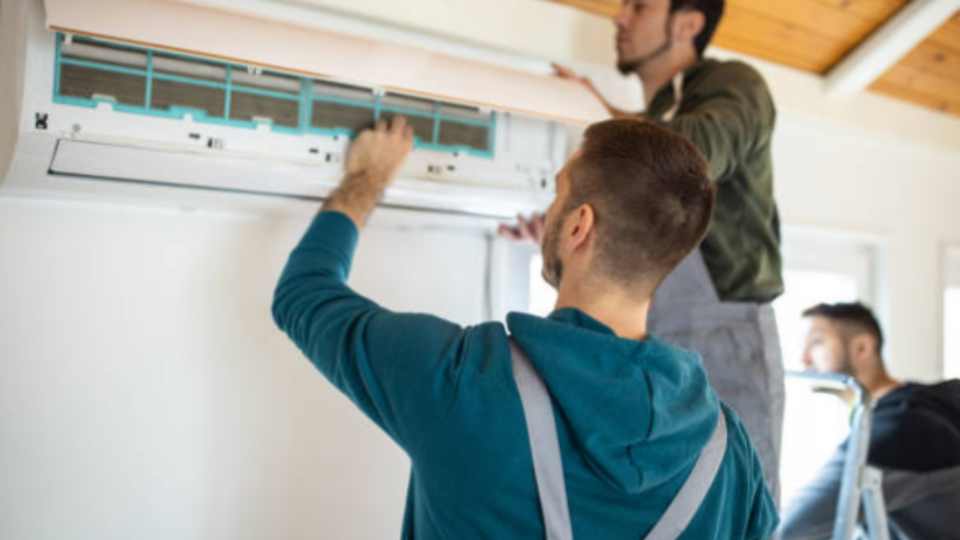Humidity levels in your home play a major role in the quality of the air you breathe. From your comfort level to your health, keeping indoor air quality at its best goes beyond just ventilation and air purification. It’s about striking the right balance in humidity.
Too much or too little can both create issues that can affect your health and the longevity of your home. Let’s dive into how humidity affects indoor air quality and what you can do to control it.
What is the ideal humidity level for indoor air quality?
When it comes to indoor air quality, the ideal humidity level generally falls between 30% to 50%. This range is comfortable for most people and supports better air quality while preventing common problems caused by both excess and too little humidity.
- 30% to 50% humidity ensures the air isn’t too dry, which can lead to skin irritation, dry eyes, and increased static electricity. It also prevents the air from being overly damp, which can encourage mold growth and contribute to dust mites or other allergens.
- Maintaining this range also supports the optimal functioning of HVAC systems, as they operate more efficiently in stable conditions.
If your home’s humidity falls outside of this range, you may notice discomfort in both your breathing and general well-being. The balance of humidity affects everything from your respiratory health to the health of your home. This makes understanding how humidity can shift and impact air quality essential.
How does high humidity impact indoor air quality?
On the other end of the spectrum, high humidity anything above 60% can be problematic. Excess moisture in the air can cause a number of issues that affect both your health and the structural integrity of your home. Here’s how:
- Mold Growth: High humidity encourages mold and mildew growth, especially in hidden areas like basements, bathrooms, and attics. Mold not only damages your home’s structure but also releases spores that can cause respiratory issues, particularly in individuals with asthma, allergies, or other respiratory conditions.
- Increased Dust Mites: These microscopic creatures thrive in moist environments. When the air is humid, they multiply, which can worsen allergies and asthma. Dust mites are known to be a major allergen, triggering sneezing, runny noses, and itchy eyes.
- Musty Odors: The excess moisture in the air can lead to a damp, musty smell that seems to permeate the whole house. This isn’t just unpleasant, it’s also an indication that your home could have hidden moisture problems, like leaks or poor ventilation.
- Condensation on Surfaces: High humidity can cause condensation to form on windows, walls, and ceilings. Over time, this moisture can damage woodwork, paint, and wallpaper, leading to costly repairs.
- Increased Risk of Respiratory Illnesses: Breathing in too much moisture or mold spores can aggravate the lungs and airways, potentially leading to coughing, wheezing, and even chronic respiratory issues over time.
While it’s easy to assume that humidity only affects comfort, it goes beyond that. High humidity can introduce serious health risks and damage the home itself. Keeping humidity at an optimal level can make a world of difference.
Can low humidity cause indoor air quality problems?
Just as too much moisture can create problems, too little humidity can also lead to several indoor air quality concerns. In winter, for example, the dry, cold air outside often lowers the humidity inside, making your home feel drier and more uncomfortable. Here’s what happens when the air gets too dry:
- Dry Skin and Eyes: Low humidity draws moisture out of your skin, leaving it dry, cracked, and irritated. Similarly, the dry air can cause your eyes to itch or burn. These uncomfortable symptoms are common in environments where the air is too dry.
- Respiratory Irritation: Breathing dry air can irritate the respiratory system, leading to dry throats, nosebleeds, and coughing. It can exacerbate existing conditions like asthma and allergies by making the airways more sensitive to irritants.
- Static Electricity: Dry air contributes to an increase in static electricity, which can lead to annoying shocks when touching metal objects, doorknobs, or other people. While this may seem minor, it can be bothersome, especially in colder months.
- Increased Risk of Illness: Low humidity can reduce the effectiveness of your body’s natural defense mechanisms, such as the mucous membranes in the respiratory tract. Dry air can cause these defenses to weaken, making you more susceptible to colds and flu.
- Damage to Wooden Furnishings and Musical Instruments: The lack of moisture can cause wooden furniture, flooring, and even musical instruments like pianos to crack and warp over time. This can result in costly repairs and replacements.
So, while many people focus on high humidity, it’s important to remember that low humidity is just as much a concern. Both extremes come with their own set of challenges, and finding the right balance is essential to maintaining indoor air quality.
What are the best ways to control indoor humidity?
Now that we understand the impact both high and low humidity can have on your home’s air quality, it’s time to explore ways to control indoor humidity. Fortunately, there are several methods you can use to keep it in that ideal 30% to 50% range. Here are some effective strategies:
- Use Humidifiers and Dehumidifiers:
- Humidifiers add moisture to the air, which can be helpful in winter months when indoor air tends to be drier. These devices are especially beneficial for those with dry skin, respiratory issues, or allergies.
- Dehumidifiers remove excess moisture from the air, which is particularly helpful in humid climates or during the summer. A dehumidifier can also help prevent mold and mildew growth, as well as reduce dust mites.
- Humidifiers add moisture to the air, which can be helpful in winter months when indoor air tends to be drier. These devices are especially beneficial for those with dry skin, respiratory issues, or allergies.
- Proper Ventilation:
Regularly ventilating your home is crucial for controlling humidity. Exhaust fans in bathrooms, kitchens, and laundry rooms help remove excess moisture from daily activities like showering or cooking. Opening windows or using air exchange systems also helps balance indoor humidity levels. - Air Conditioning:
Air conditioners not only cool your home but also dehumidify the air. In fact, running an air conditioner during hot, humid months can prevent the air from becoming too damp, while also keeping your home comfortable. - Check for Leaks:
Small leaks in your roof, windows, or pipes can cause excess moisture to seep into your home, especially in high humidity areas. Regularly inspecting your home and repairing any leaks will help control moisture levels and prevent mold growth. - Use Moisture Absorbers:
Moisture-absorbing products like silica gel, activated charcoal, or calcium chloride can be placed in areas prone to excess humidity, such as basements or closets. These can help regulate moisture levels and keep the air fresh. - Maintain a Consistent Temperature:
Keeping the temperature in your home relatively stable can help maintain the ideal humidity level. If your home experiences wide temperature swings, it can affect the moisture in the air, leading to spikes in humidity.
Maintaining balanced humidity levels doesn’t have to be complicated. With the right tools and a little attention to detail, you can keep your indoor air quality at its best.
Elite Air & Heat LLC: Your Partner in Healthy, Comfortable Air Quality
At Elite Air & Heat LLC, we understand how crucial it is to maintain ideal humidity levels in your home. Our expert services can help you achieve the perfect balance of moisture for your indoor air quality. Whether you need to install a humidifier, dehumidifier, or ensure your HVAC system is operating efficiently, we’re here to help.
We offer personalized solutions to improve the air you breathe, ensuring a healthier, more comfortable living space year-round. Don’t wait—get in touch with us today to take control of your home’s humidity and enjoy better indoor air quality.




